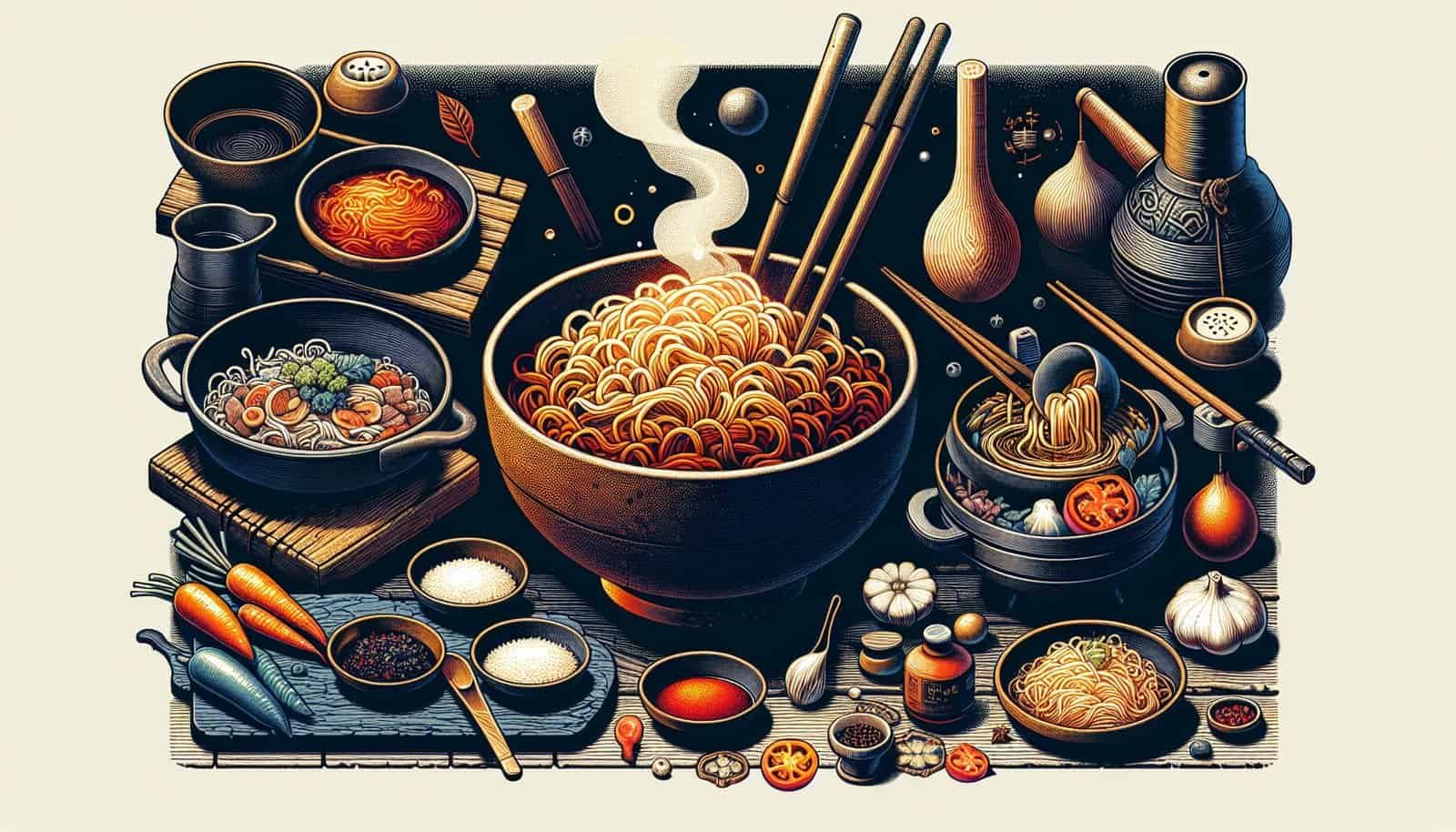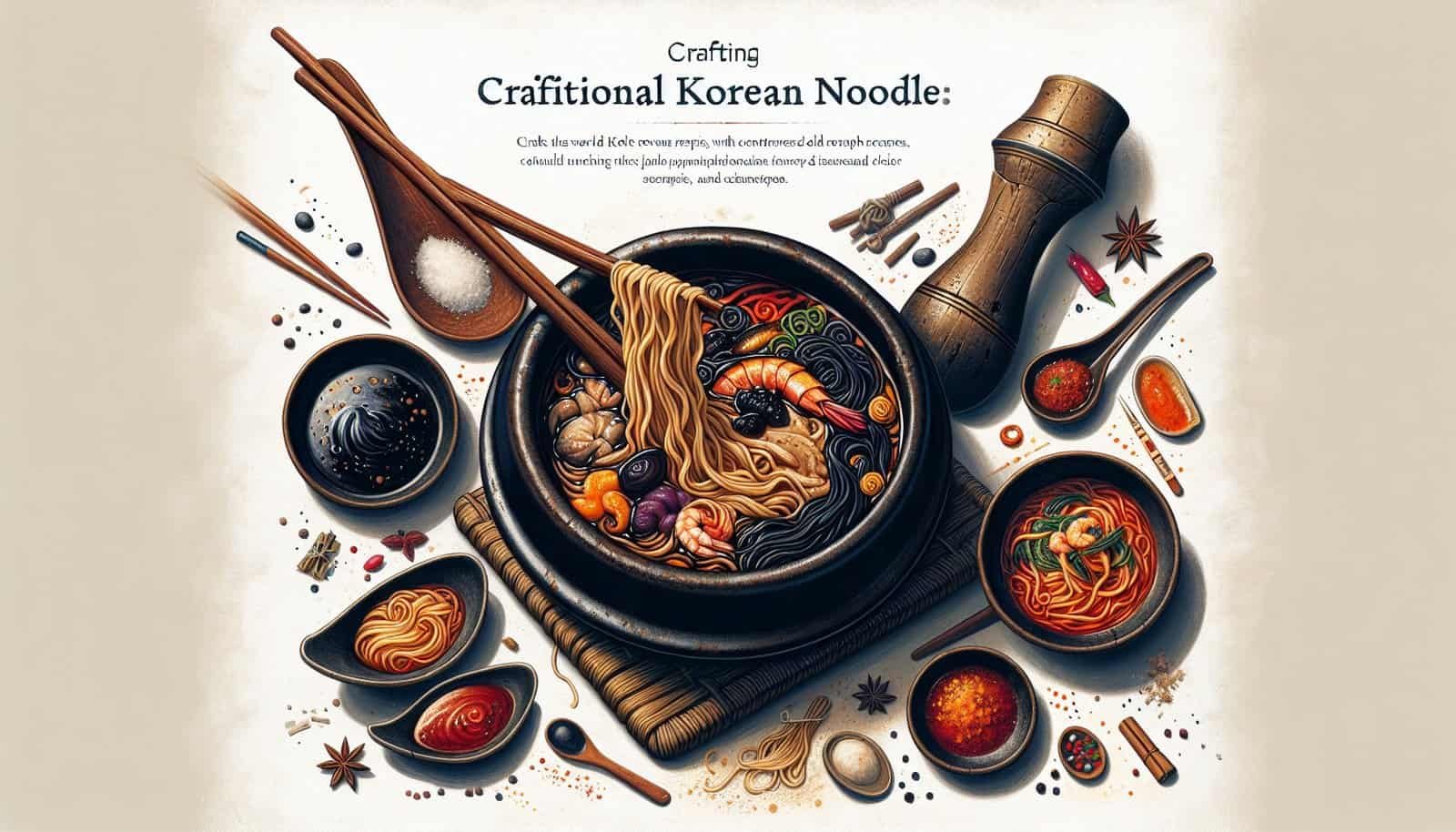Have you ever wondered how traditional Korean noodles, such as jjajangmyeon and jjamppong, are prepared? The process of making these mouthwatering dishes is a delicate art, carefully blending a variety of flavors and textures. From the rich, savory black bean sauce of jjajangmyeon to the spicy, briny broth of jjamppong, each dish showcases the unique culinary traditions of Korea. Join us on a culinary journey as we explore the intricate steps involved in creating these beloved Korean noodle dishes.
Overview of Korean Noodles
Introduction to Korean Noodles
Korean noodles have been a staple in Korean cuisine for centuries, known for their delicious flavors and unique textures. Noodles play a significant role in Korean meals, whether as a main dish or a side dish. From the famous Jjajangmyeon to the fiery Jjamppong, Korean noodles offer a wide range of options for noodle lovers around the world.
Popular Traditional Korean Noodles
When it comes to traditional Korean noodles, two dishes stand out: Jjajangmyeon and Jjamppong. Jjajangmyeon is a black bean sauce noodle dish, while Jjamppong is a spicy seafood noodle soup. These two dishes have gained immense popularity both within Korea and internationally, becoming a symbol of Korean culinary excellence.
Ingredients Used in Korean Noodles
Korean noodles primarily feature ingredients such as wheat flour, potato starch, and sweet potato starch. These different types of flour are expertly combined to create a variety of noodle textures, from chewy to soft. Additionally, Korean noodles incorporate various sauces, spices, vegetables, and proteins to enhance the overall flavor and complexity of the dish.
Preparation of Jjajangmyeon
Brief Introduction to Jjajangmyeon
Jjajangmyeon is a quintessential Korean comfort food that originated in China but has become deeply rooted in Korean cuisine. This dish features thick, hand-pulled noodles topped with a rich, savory black bean sauce and a variety of vegetables and protein. Its robust flavors and satisfying texture make it a favorite among Koreans and foreigners alike.
Ingredients for Jjajangmyeon
The key ingredients for Jjajangmyeon include black bean paste, diced pork or beef, various vegetables such as onions, zucchini, and potatoes, as well as noodles. The black bean paste, made from fermented soybeans, gives the dish its distinct dark color and intense flavor. The choice of protein and vegetables can vary, allowing for flexibility and personalization in preparing this dish.
Step-by-step Instructions for Jjajangmyeon
- Begin by preparing the noodles. Boil them until they are cooked to your desired level of tenderness. Drain the noodles and set them aside.
- In a separate pan, heat oil and sauté diced pork or beef until it is cooked through. Add chopped onions, zucchini, and potatoes, and continue to stir-fry until the vegetables are tender.
- Add black bean paste to the pan and cook it with the meat and vegetables, stirring constantly to ensure it coats everything evenly. This process will activate the flavors of the black bean paste.
- Once the sauce has thickened, add a bit of water or broth to achieve the desired consistency. Continue to simmer for a few minutes.
- Serve the black bean sauce over the cooked noodles and garnish with sliced cucumbers or pickled radish, if desired. Enjoy your homemade Jjajangmyeon!

Preparation of Jjamppong
Brief Introduction to Jjamppong
Jjamppong, also known as Korean Spicy Seafood Noodle Soup, is a beloved Korean dish that packs a punch. This spicy and hearty soup features a variety of seafood, vegetables, and noodles in a flavorful, fiery broth. It is an ideal dish for those who appreciate bold flavors and enjoy a little heat in their meals.
Ingredients for Jjamppong
The ingredients for Jjamppong include a mixture of fresh seafood such as shrimp, clams, and squid, together with vegetables like onions, carrots, cabbage, and green onions. The fiery broth is created using red chili pepper paste and a blend of aromatic seasonings. The noodles used in Jjamppong are typically thick and chewy, providing a satisfying texture.
Step-by-step Instructions for Jjamppong
- Begin by preparing the seafood. Clean the shrimp, clams, and squid thoroughly and set them aside.
- In a large pot, heat oil and sauté chopped onions until they become translucent. Add minced garlic and continue to cook for another minute.
- Add the seafood to the pot and stir-fry briefly, just until the shrimp turns pink and the clams begin to open.
- Pour water or seafood broth into the pot. Add red chili pepper paste, soy sauce, and other seasonings to create the spicy and flavorful broth. Simmer for a few minutes to develop the flavors.
- Add the vegetables, such as carrots, cabbage, and green onions, and cook until they are tender.
- In a separate pot, cook the noodles according to the package instructions. Make sure not to overcook them as they will continue to cook in the hot soup.
- Drain the noodles and divide them into individual serving bowls. Ladle the hot jjamppong broth and seafood over the noodles. Garnish with additional green onions or shredded seaweed, if desired. Enjoy your spicy and hearty Jjamppong!
Comparison between Jjajangmyeon and Jjamppong
Differences in Flavor Profiles
Jjajangmyeon and Jjamppong offer distinct flavor profiles. Jjajangmyeon has a rich, savory taste with a hint of sweetness from the black bean sauce. On the other hand, Jjamppong is known for its fiery and spicy flavor, derived from the combination of red chili pepper paste and other aromatic seasonings. Depending on personal preferences, one can choose between the umami richness of Jjajangmyeon or the bold spiciness of Jjamppong.
Contrasting Ingredients
The ingredients used in Jjajangmyeon and Jjamppong also differ significantly. Jjajangmyeon features black bean paste, diced meat, and a variety of vegetables, such as onions, zucchini, and potatoes. On the other hand, Jjamppong highlights a combination of seafood, including shrimp, clams, and squid, along with vegetables like onions, carrots, cabbage, and green onions. These varying combinations of ingredients contribute to the unique flavors and textures of the respective dishes.
Preparation Techniques
The preparation techniques for Jjajangmyeon and Jjamppong also exhibit notable differences. Jjajangmyeon involves stir-frying the black bean paste with meat and vegetables to create a thick and flavorful sauce. In contrast, Jjamppong requires cooking the seafood and vegetables in a spicy broth. The contrasting techniques used in preparing these dishes contribute to their individual characteristics and overall taste.

Tips and Tricks
Choosing the Right Noodles
When preparing Korean noodle dishes, it is essential to choose the appropriate noodles to achieve the desired texture and flavor. For Jjajangmyeon, opt for thick, chewy noodles that can hold the robust black bean sauce well. On the other hand, Jjamppong pairs well with thicker noodles that can withstand the heat of the spicy broth. Remember to cook the noodles just right, ensuring they are not overcooked or undercooked.
Enhancing the Flavor
To enhance the flavors of Korean noodle dishes, consider adding extra ingredients or seasonings. For Jjajangmyeon, adding diced vegetables, such as cucumbers or carrots, as garnish can provide a fresh crunch and balance the richness of the black bean sauce. In the case of Jjamppong, a dash of sesame oil or a squeeze of lemon juice can elevate the taste of the spicy seafood broth.
Garnishing Ideas
Garnishing Korean noodle dishes adds visual appeal and additional flavors. For Jjajangmyeon, consider topping the dish with thinly sliced cucumbers or pickled radish to provide a refreshing and tangy contrast. Jjamppong can be garnished with shredded seaweed, green onions, or even a sprinkle of chili flakes to add a touch of vibrancy and texture.
Variations of Korean Noodles
Other Popular Traditional Korean Noodles
Apart from Jjajangmyeon and Jjamppong, traditional Korean cuisine boasts various other noodle dishes worth exploring. Bibim Guksu, a cold noodle dish dressed in spicy and tangy sauce, is perfect for hot summer days. Naengmyeon, served in a refreshing broth with thin buckwheat noodles and toppings like cucumbers and Korean pear, offers a unique taste. Diverse regional specialties showcase different noodle styles and flavors across Korea.
Regional Specialties
Different regions of Korea have their own unique noodle specialties. For example, in Andong, the home of Andong Jjimdak, Jjimdak Noodles are renowned for their thick, chewy texture and rich flavors. In Gangwon Province, Makguksu stands out, featuring buckwheat noodles served with a spicy sauce and a variety of vegetables. Exploring these regional specialties provides a deeper understanding of the diversity within Korean noodle cuisine.
Vegetarian and Vegan Options
Korean cuisine offers a variety of vegetarian and vegan options for noodle lovers. Dishes such as Kongguksu, made with chilled soy milk broth and wheat noodles, provide a refreshing and nutritious choice. Japchae, made with sweet potato glass noodles stir-fried with an assortment of colorful vegetables, is another popular vegetarian option. These dishes showcase the versatility and adaptability of Korean noodles to cater to different dietary preferences.

Health Benefits of Korean Noodles
Nutritional Value
Korean noodles, when prepared with balanced ingredients, offer a range of nutritional benefits. They are a good source of carbohydrates, which provide energy for the body. Additionally, protein from ingredients like meat, seafood, or vegetarian alternatives contributes to muscle development. The abundant vegetables and seasonings in Korean noodle dishes also provide essential vitamins and minerals, making them a wholesome choice.
Good Source of Fiber
Many Korean noodle dishes incorporate vegetables, which are high in fiber. Fiber is essential for maintaining a healthy digestive system and preventing constipation. The combination of noodles and fiber-rich ingredients in Korean dishes promotes good gut health and aids in the overall digestion process.
Potential Health Risks
While Korean noodles can be a healthy choice, certain factors should be considered. Some dishes, such as Jjajangmyeon, may contain high levels of sodium and fat due to the black bean paste and meat used. It is essential to consume these dishes in moderation, especially if you have dietary restrictions or health concerns. Additionally, individuals with gluten sensitivities should opt for gluten-free noodle alternatives to avoid any adverse reactions.
Famous Restaurants for Korean Noodles
Iconic Noodle Shops in South Korea
South Korea is home to numerous renowned noodle shops that have become institution-like establishments. In Seoul, Myeongdong Kyoja offers delicious kalguksu (knife-cut noodles) and mandu (dumplings) that have won the hearts of locals and tourists alike. In Busan, Milmyeon Alley is famous for its Milmyeon, a cold and spicy noodle dish, showcasing the remarkable diversity within Korean noodle cuisine.
Global Expansion of Korean Noodle Cuisine
The popularity of Korean noodles has extended far beyond Korean borders. Korean restaurants, specializing in different noodle dishes, can now be found in various countries around the world. From London to New York City, people are embracing the unique flavors and textures of Korean noodles. This global expansion allows individuals from diverse backgrounds to experience the rich culinary heritage of Korea.
Must-Try Noodle Dishes
When exploring Korean noodles, be sure to try some of the must-try dishes available. Naengmyeon, the cold and tangy buckwheat noodles, is perfect for refreshing your palate. For a spicy kick, try the Janchi Guksu, a warm noodle dish served in a savory broth with vegetables. For those seeking a vegetarian option, Japchae and Kongguksu offer delightful flavors that cater to a variety of taste preferences.

Cultural Significance
Historical Background
Noodles have a long history in Korean cuisine, with influences from China and Japan. The introduction of noodles to Korea is believed to have occurred during the Three Kingdoms Period. Over time, Korean noodle dishes have evolved and gained their distinct identity, reflecting the unique cultural heritage of the Korean people.
Noodles in Korean Cuisine
Noodles play a significant role in Korean cuisine, evident in various dishes and cultural practices. Korean cuisine values the concept of “harmony” in flavors, and noodles contribute to achieving this balance. From celebratory meals to everyday fare, noodles hold a special place in Korean culinary traditions.
Noodles in Korean Festivals
Korean festivals often feature specific noodle dishes that hold cultural and symbolic significance. During Lunar New Year celebrations, Tteokguk, a traditional Korean rice cake soup with sliced rice cakes resembling noodles, is a staple dish. The act of consuming these special noodles is believed to bring good luck and a prosperous year ahead.
Conclusion
Summary of Traditional Korean Noodles
Traditional Korean noodles, such as Jjajangmyeon and Jjamppong, have captured the hearts and taste buds of people worldwide. Their unique flavors, textures, and the art of their meticulous preparation are testaments to the richness of Korean culinary heritage. Whether you are a fan of the rich, savory notes of Jjajangmyeon or crave the fiery spiciness of Jjamppong, Korean noodles offer a world of exploration and culinary delight.
Appreciating the Unique Taste
The beauty of Korean noodles lies in their ability to combine various ingredients, spices, and techniques to create dishes that are both comforting and exciting. Their distinctive flavors and the diversity of options allow individuals to tailor their noodle experience to their preferences, while still appreciating the classic flavors that make Korean noodles so beloved.
Exploring the Culinary World of Korea
As you delve into the world of Korean noodles, remember to explore beyond the well-known dishes. Venture into regional specialties, try vegetarian and vegan options, and experiment with different noodle types and garnishes. Embrace the cultural significance of Korean noodles and savor the flavors that have been perfected over centuries. Korean noodles offer a culinary journey that will undoubtedly leave you wanting more.

